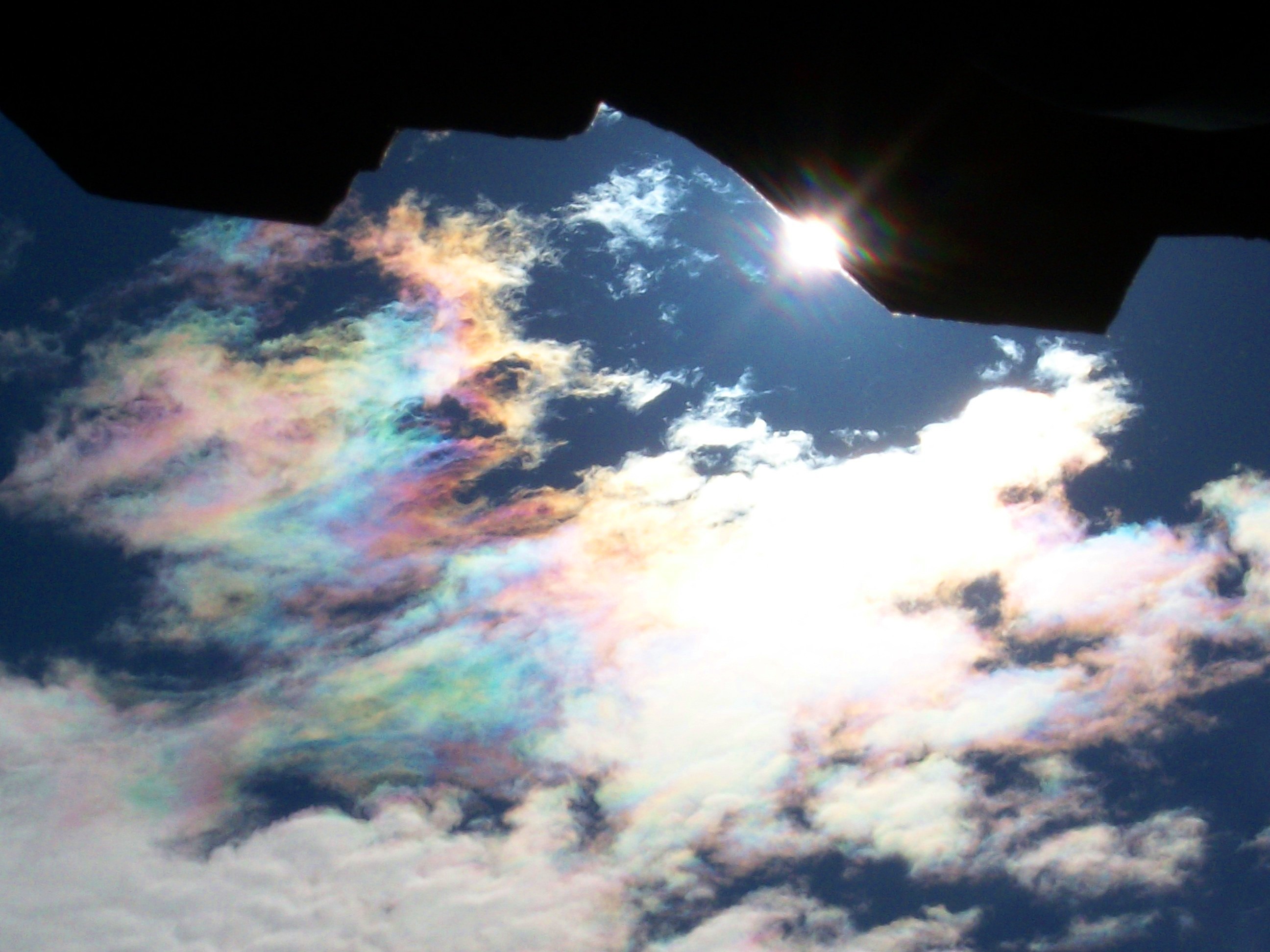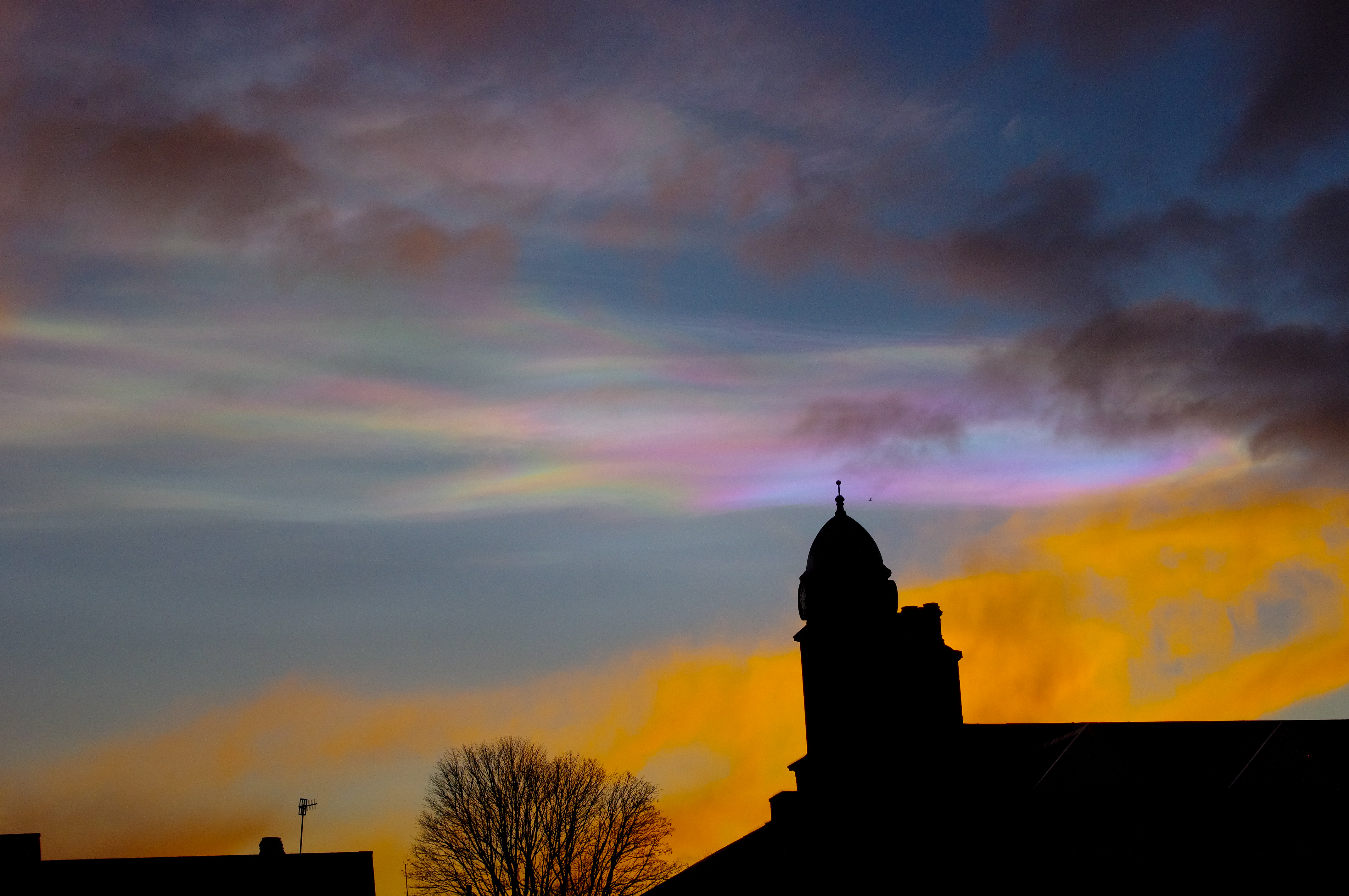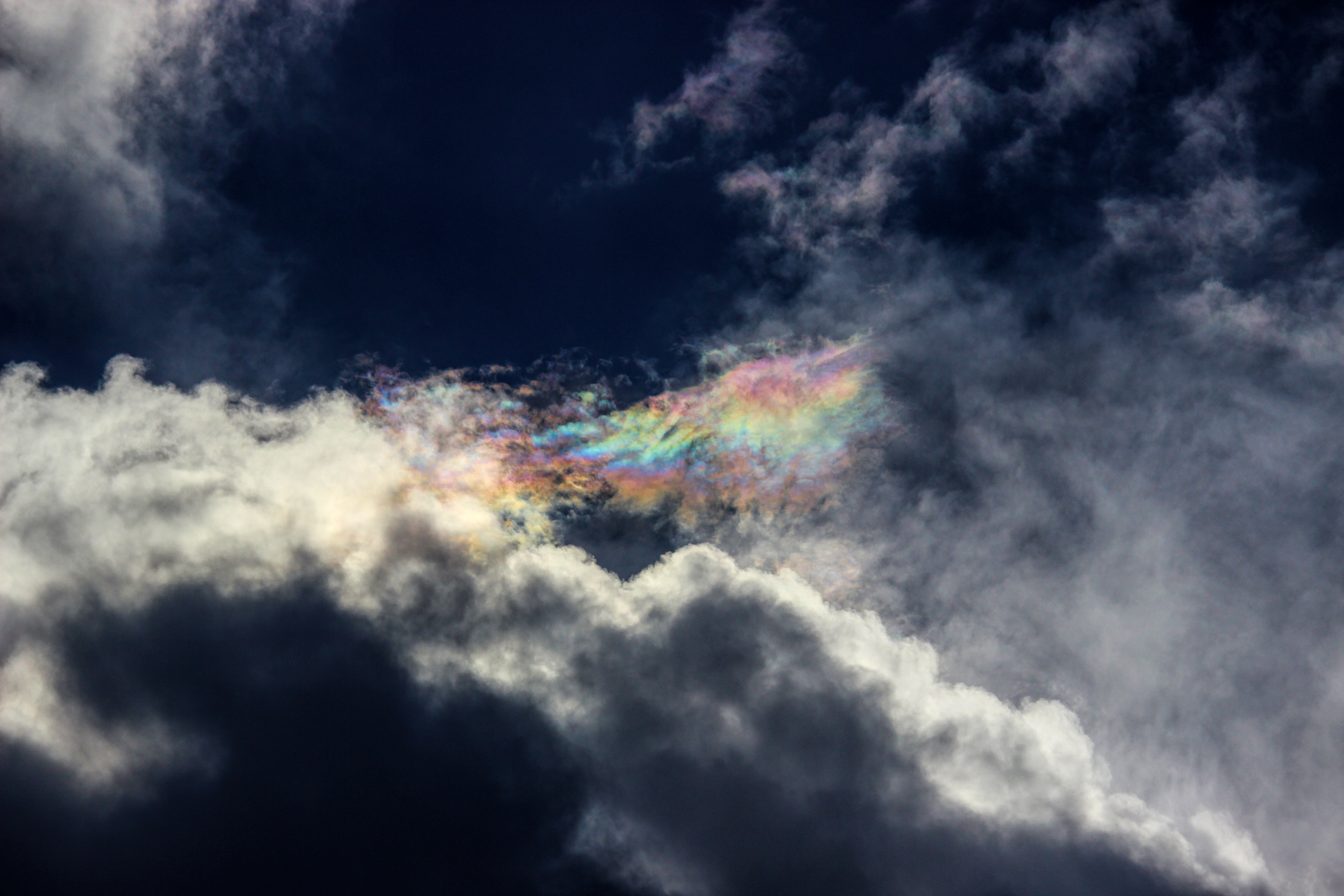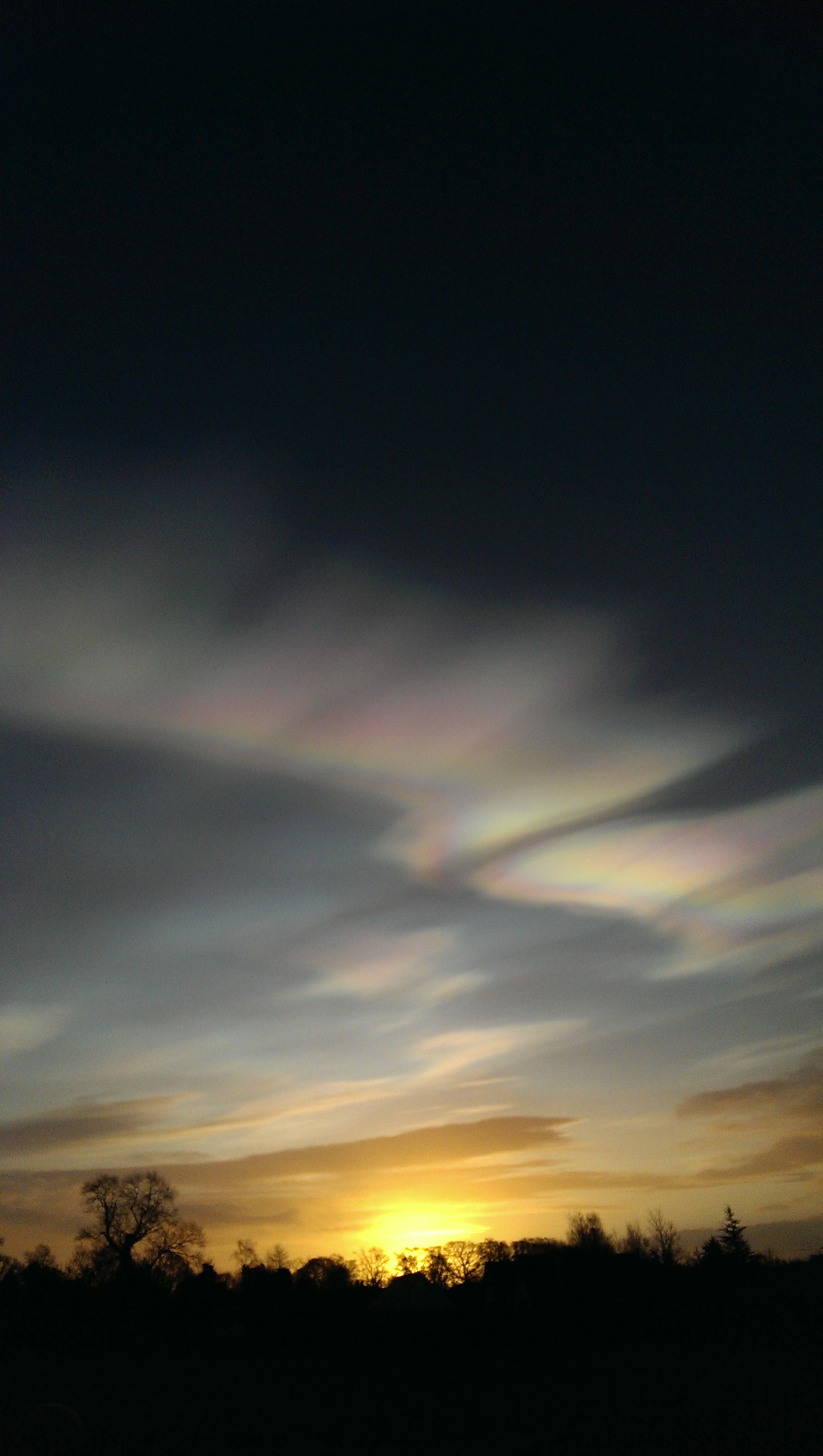Iridescent Cloud on:
[Wikipedia]
[Google]
[Amazon]



 Cloud iridescence or irisation is a colorful
Cloud iridescence or irisation is a colorful
File:CircumHorizontalArc GQ 07312012 1938.jpg
File:Iridclouds2.jpg
File:IridescentCloudArran.jpg
File:Stratocumulus fibrous fishscali-1.jpg
File:Iridescent Cloud.JPG
File:Cloud iridescence 3.jpg
File:CloudOberGatlinburg.jpg
File:Cloud iridescence at Kokkola, Finland.jpg
File:IrisationCloudsPICT4884crop640x480.jpg, Irisation in clouds over Wellington NZ
File:Irisation or iridescence in super-cooled cloud - NOAA.jpg, Irisation or iridescence in super-cooled cloud droplets in
Iridescent cloud gallery - Atmospheric Optics site
-



 Cloud iridescence or irisation is a colorful
Cloud iridescence or irisation is a colorful optical phenomenon
Optical phenomena are any observable events that result from the interaction of light and matter.
All optical phenomena coincide with quantum phenomena. Common optical phenomena are often due to the interaction of light from the sun or moon wit ...
that occurs in a cloud
In meteorology, a cloud is an aerosol consisting of a visible mass of miniature liquid droplets, frozen crystals, or other particles suspended in the atmosphere of a planetary body or similar space. Water or various other chemicals may co ...
and appears in the general proximity of the Sun
The Sun is the star at the center of the Solar System. It is a nearly perfect ball of hot plasma, heated to incandescence by nuclear fusion reactions in its core. The Sun radiates this energy mainly as light, ultraviolet, and infrared radi ...
or Moon
The Moon is Earth's only natural satellite. It is the fifth largest satellite in the Solar System and the largest and most massive relative to its parent planet, with a diameter about one-quarter that of Earth (comparable to the width of ...
. The colors resemble those seen in soap bubble
A soap bubble is an extremely thin film of soap or detergent and water enclosing air that forms a hollow sphere with an iridescent surface. Soap bubbles usually last for only a few seconds before bursting, either on their own or on contact wi ...
s and oil on a water surface. It is a type of photometeor In atmospheric optics, a photometeor is a bright object or other optical phenomenon appearing in the Earth's atmosphere when sunlight or moonlight creates a reflection, refraction, diffraction or interference under particular circumstances. The mo ...
. This fairly common phenomenon is most often observed in altocumulus
Altocumulus (From Latin ''Altus'', "high", ''cumulus'', "heaped") is a middle-altitude cloud genus that belongs mainly to the ''stratocumuliform'' physical category characterized by globular masses or rolls in layers or patches, the individual ele ...
, cirrocumulus
Cirrocumulus is one of the three main genus-types of high-altitude tropospheric clouds, the other two being cirrus and cirrostratus. They usually occur at an altitude of . Like lower-altitude cumuliform and stratocumuliform clouds, cirrocumulus s ...
, lenticular, and cirrus cloud
Cirrus ( cloud classification symbol: Ci) is a genus of high cloud made of ice crystals. Cirrus clouds typically appear delicate and wispy with white strands. Cirrus are usually formed when warm, dry air rises, causing water vapor deposition on ...
s. They sometimes appear as bands parallel to the edge of the clouds. Iridescence is also seen in the much rarer polar stratospheric cloud
Polar stratospheric clouds (PSCs) are clouds in the winter polar stratosphere at altitudes of . They are best observed during civil twilight, when the Sun is between 1 and 6 degrees below the horizon, as well as in winter and in more northerly l ...
s, also called nacreous clouds.
The colors are usually pastel
A pastel () is an art medium in a variety of forms including a stick, a square a pebble or a pan of color; though other forms are possible; they consist of powdered pigment and a binder. The pigments used in pastels are similar to those use ...
, but can be very vivid
Vivid may refer to:
Music
* Vivid (band), a Japanese rock band
* "Vivid" (song), by Electronic, 1999
*"ViViD", a 2016 song by Loona from '' HeeJin''
Albums
* ''Vivid'' (Vivian Green album), 2015
* ''Vivid'' (Crystal Kay album), 2012
* ''Vivi ...
or mingled together, sometimes similar to mother-of-pearl
Nacre ( , ), also known as mother of pearl, is an organicinorganic composite material produced by some molluscs as an inner shell layer; it is also the material of which pearls are composed. It is strong, resilient, and iridescent.
Nacre is f ...
. When appearing near the Sun, the effect can be difficult to spot as it is drowned in the Sun's glare. This may be overcome by shielding the sunlight
Sunlight is a portion of the electromagnetic radiation given off by the Sun, in particular infrared, visible, and ultraviolet light. On Earth, sunlight is scattered and filtered through Earth's atmosphere, and is obvious as daylight when t ...
with one's hand or hiding it behind a tree or building. Other aids are dark glasses, or observing the sky reflected in a convex mirror or in a pool of water.
Etymology
Irisations are named after the Greek goddessIris
Iris most often refers to:
*Iris (anatomy), part of the eye
*Iris (mythology), a Greek goddess
* ''Iris'' (plant), a genus of flowering plants
* Iris (color), an ambiguous color term
Iris or IRIS may also refer to:
Arts and media
Fictional ent ...
, goddess of rainbow
A rainbow is a meteorological phenomenon that is caused by reflection, refraction and dispersion of light in water droplets resulting in a spectrum of light appearing in the sky. It takes the form of a multicoloured circular arc. Rainbows c ...
s and messenger of Zeus
Zeus or , , ; grc, Δῐός, ''Diós'', label=Genitive case, genitive Aeolic Greek, Boeotian Aeolic and Doric Greek#Laconian, Laconian grc-dor, Δεύς, Deús ; grc, Δέος, ''Déos'', label=Genitive case, genitive el, Δίας, ''D� ...
and Hera
In ancient Greek religion, Hera (; grc-gre, Ἥρα, Hḗrā; grc, Ἥρη, Hḗrē, label=none in Ionic and Homeric Greek) is the goddess of marriage, women and family, and the protector of women during childbirth. In Greek mythology, she ...
to the mortals below.
Mechanism
Iridescent clouds are adiffraction
Diffraction is defined as the interference or bending of waves around the corners of an obstacle or through an aperture into the region of geometrical shadow of the obstacle/aperture. The diffracting object or aperture effectively becomes a s ...
phenomenon caused by small water droplets or small ice crystals
Ice crystals are solid ice exhibiting atomic ordering on various length scales and include hexagonal columns, hexagonal plates, dendritic crystals, and diamond dust.
Formation
The hugely symmetric shapes are due to depositional growth, n ...
individually scattering light. Larger ice crystals do not produce iridescence, but can cause halos, a different phenomenon.
Irisation is caused by very uniform water droplets diffracting light (within 10 degrees from the Sun
The Sun is the star at the center of the Solar System. It is a nearly perfect ball of hot plasma, heated to incandescence by nuclear fusion reactions in its core. The Sun radiates this energy mainly as light, ultraviolet, and infrared radi ...
) and by first order interference
Interference is the act of interfering, invading, or poaching. Interference may also refer to:
Communications
* Interference (communication), anything which alters, modifies, or disrupts a message
* Adjacent-channel interference, caused by extr ...
effects (beyond about 10 degrees from the Sun). It can extend up to 40 degrees from the Sun.
If parts of clouds contain small water droplets or ice crystals of similar size, their cumulative effect is seen as colors. The cloud must be optically thin, so that most rays encounter only a single droplet. Iridescence is therefore mostly seen at cloud edges or in semi-transparent
Transparency, transparence or transparent most often refer to:
* Transparency (optics), the physical property of allowing the transmission of light through a material
They may also refer to:
Literal uses
* Transparency (photography), a still, ...
clouds, while newly forming clouds produce the brightest and most colorful iridescence. When the particles in a thin cloud are very similar in size over a large extent, the iridescence takes on the structured form of a corona
Corona (from the Latin for 'crown') most commonly refers to:
* Stellar corona, the outer atmosphere of the Sun or another star
* Corona (beer), a Mexican beer
* Corona, informal term for the coronavirus SARS-CoV-2, which causes the COVID-19 di ...
, a bright circular disk around the Sun or Moon surrounded by one or more colored rings.
Gallery
cirrocumulus
Cirrocumulus is one of the three main genus-types of high-altitude tropospheric clouds, the other two being cirrus and cirrostratus. They usually occur at an altitude of . Like lower-altitude cumuliform and stratocumuliform clouds, cirrocumulus s ...
clouds.
File:Iridescent Cirrus behind Stratocumulus over Warsaw, June 26, 2005.jpg, Irisation in cirrus
Cirrus may refer to:
Science
*Cirrus (biology), any of various thin, thread-like structures on the body of an animal
*Cirrus (botany), a tendril
* Infrared cirrus, in astronomy, filamentary structures seen in infrared light
*Cirrus cloud, a typ ...
(or maybe cirrocumulus) clouds behind Stratocumulus
A stratocumulus cloud, occasionally called a cumulostratus, belongs to a genus-type of clouds characterized by large dark, rounded masses, usually in groups, lines, or waves, the individual elements being larger than those in altocumulus, and th ...
(bottom), in the afternoon over Warsaw, Poland.
File:Cloud Iridescence and Crepuscular Rays.jpg, Vibrant cloud iridescence captured before sunset
File:Iridescent cloud edge.jpg
File:At Teide Observatory 2019 027.jpg, Iridescent clouds seen in Tenerife
File:Cloud-iridescence-Parker-Canyon-AZ-Aug-6-2022.jpg, Parker Canyon, AZ. Aug 6th, 2022
See also
*Polar stratospheric cloud
Polar stratospheric clouds (PSCs) are clouds in the winter polar stratosphere at altitudes of . They are best observed during civil twilight, when the Sun is between 1 and 6 degrees below the horizon, as well as in winter and in more northerly l ...
* Circumhorizontal arc
A circumhorizontal arc is an optical phenomenon that belongs to the family of ice halos formed by the refraction of sunlight or moonlight in plate-shaped ice crystals suspended in the atmosphere, typically in cirrus or cirrostratus clouds. In i ...
* Noctilucent cloud
Noctilucent clouds, or night shining clouds, are tenuous cloud-like phenomena in the upper atmosphere of Earth. When viewed from space, they are called polar mesospheric clouds (PMCs), detectable as a diffuse scattering layer of water ice cryst ...
References
External links
Iridescent cloud gallery - Atmospheric Optics site
-
Scientific American
''Scientific American'', informally abbreviated ''SciAm'' or sometimes ''SA'', is an American popular science magazine. Many famous scientists, including Albert Einstein and Nikola Tesla, have contributed articles to it. In print since 1845, it i ...
Supplement
Cloud types
Atmospheric optical phenomena
{{Cloud-stub